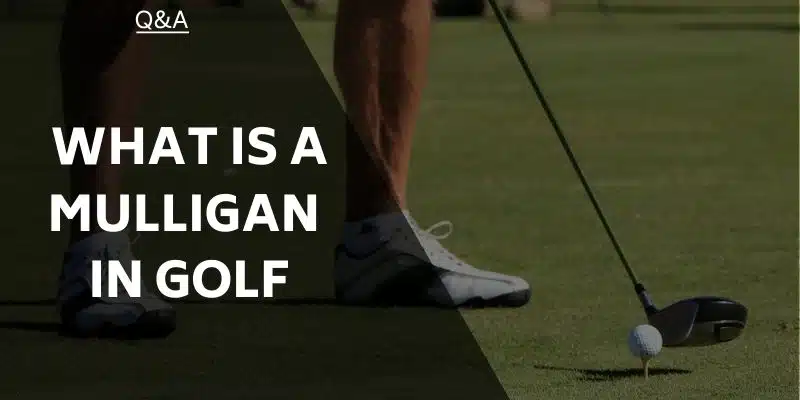Are you new to golf and overwhelmed by all the unfamiliar terms thrown around? Or maybe you’ve been playing for a while but still feel like you’re missing something when your group starts chatting on the course. Either way, we’ve got you covered with our Golf Slang 101 guide.
We’ll explain all the key terms you need to know in it. Mastering golf lingo will equip you with an arsenal of puns to impress your friends. It will also make following TV coverage of the PGA Tour much easier.
Types of Golf Slang
Golf has a distinct culture and language of its own.
Colorful and often, random golf slang is used as the standard communication medium among golfers. If you’re unfamiliar with it, it can feel completely alien.
Let’s start with some interesting examples.
Regarding golf shot terms, you might have heard of a “rain-maker.” This refers to a shot with a high launch angle and trajectory.
You might not have heard of the term “lumberjack,” but if you’re a high handicapper, you have probably been one. It is when a golfer hits the ball into the woods, and their attempts to play back onto the fairway result in multiple ricochets against the trees.
I know. If you shut your eyes, you can hear the hollow echo of birch trees that have just been struck by your wayward attempts to hit a low stinger with a 6 iron. We’ve all been there.
When it comes to golf equipment, you probably hear a lot of people talking about the “loft.” This simply refers to the angle of the club’s face—higher loft = more spin, more height, and less distance.
“Links” refers to coastal golf courses such as St Andrews in Scotland.
Most Common Golf Slang Terms

Part of golf’s charm is its unique language. Let’s briefly cover some common golf slang terms you might have heard of.
- A “birdie” is when a golfer makes one less stroke than the par on a hole. Thus, a player must make three strokes for a birdie on a par four.
- The less desirable cousin of birdie is a “bogey,” which is making one more stroke than par.
- Two strokes under par on a given hole is an “eagle.”
- A “mulligan” is something you won’t see on tour. It is where you allow a second attempt off the tee if the first shot was particularly bad.
- A “gimme” is a very short putt in golf lingo. When a putt is so short that it is assumed you will make it, your friends can allow you to pick up your ball and count that you made the putt. There is no official length for this. It tends to come down to how competitive the round is.
- “Fore” is shouted by golfers to alert others that a ball is headed in their direction. The correct etiquette is to shout it loudly when you think your ball might land near or hit another player, spectator, or object on the course.
- “Out of bounds” refers to any area outside the golf course’s designated boundaries. If players hit their ball out of bounds, they are penalized one stroke. They must hit their next shot from where they last played it. The result is an added penalty stroke on their score.
- A “Dog-leg” is a hole with a sharp left or right turn, resembling a dog’s hind leg.
- “Green in regulation” is when you reach the putting surface of a hole in the expected number of shots or fewer. For example, taking two shots to reach the green on a par 4 would be in regulation.
Regional Golf Slang

International
- French-born golfer Jean Van de Velde coined the phrase “tam’ès pas une bonne idee” to refer to a bad decision on the course—translated it means “It’s not a good idea.”
- In Scotland, golfers will refer to a shot where they make minimal contact with the ball as a “duff.” If they are being polite, of course.
- In England, golfers use the term “Alec Guinness.” If they go out of bounds, or “O.B.” The actor played the Star Wars character Obi-Wan Kenobi. This has to be one of our favorite golf slang terms.
In the U.S.
- Texas: A “Horn” is a par-3 hole with a bunker in front of the green, resembling the shape of a bull’s horn.
- California: “Dude ball” is when a shot is hit far and high, usually with a driver or fairway wood.
- Hawaii – The “Aloha wedge” – is the lob wedge, referring to the Hawaiian greeting “aloha” and the high lofted shots the club gives you.
- Chicago – A “Windy City Mulligan” refers to taking a second shot off the tee without penalty because of the brutal wind speed in the region.
Golf Slang in Pop Culture
Golf Slang in Movies and TV
Golf lingo terms are also prominent in movies and television. Here are some of our favorites.
Caddyshack: “Cinderella Story”
A “Cinderella Story” is often used to explain an underdog’s unexpected success. It originated from the classic scene in the movie where Carl Spackler (played by Bill Murray) fantasizes about winning The Masters. He exclaims: “Cinderella story, outta nowhere!”
Tin Cup: “Tin Cup”
is a term used to describe a talented golfer who never quite reaches their full potential. The name comes from Roy “Tin Cup” McAvoy (played by Kevin Costner), a former golf prodigy who never made it to the big leagues.
Happy Gilmore: “Happy Place”
A golfer’s mental state when completely focused and in the zone. In the movie Happy Gilmore (Adam Sandler) visualizes a happy place to calm his nerves before hitting.
The Office: “Fore!”
It’s all about context with this one. Dwight Schrute screams “Fore!” when he accidentally hits a golf ball into a group of employees standing in a parking lot. Classic.
Famous Golfers Known for Using Golf Slang

Arnold Palmer
The legendary golfer is famous for coining the term “Arnie’s Army” to describe his enthusiastic fan base. Arnie has some of the most memorable golf quotes in the game’s history.
Phil Mickelson
Mickelson has made golf terminology slang popular in his own way. He is famous for talking about “The Claw” grip and “Hittin’ bombs” to describe long drives. Since his reported $200 million contract with LIV Golf, though, the rhetoric around Phil has shifted focus.
Tiger Woods
Tiger is known for his intensity and competitive spirit. He has mentioned using the phrase “Keep the hammer down” to motivate himself during tournaments.
The Most Popular Golf Slang: A to Z

Check out our A to Z of golf slang. If you want a more formal A to Z of golf terms, check our article about that.
A
Ace: A hole-in-one, when a golfer hits the ball directly from the tee into the hole with a single stroke.
Albatross: A score of three strokes under par on a hole.
Apron: The short grass surrounding the green, between the green and the rough.
B
Birdie: A score of one stroke under par on a hole.
Bunker: A hazard filled with sand, also known as a sand trap.
Bailout: A safe area to aim for when a golfer wants to avoid a hazard or obstacle.
C
Caddie: A person who carries a golfer’s clubs and offers advice on course strategy.
Chip: A short, low shot played with a wedge to land the ball on the green.
Clubhead: The part of the golf club that strikes the ball.
D
Divot: A piece of turf that is removed from the ground when a golfer strikes the ball.
Dogleg: A hole that bends at some point between the tee and the green.
Drive: The first shot taken on a hole, usually hit from the tee with a driver.
E
Eagle: A score of two strokes under par on a hole.
Etiquette: The unwritten rules of behavior on the golf course. Common etiquette includes proper attire, respect for other players, and taking care of the course.
Equipment: The various clubs, balls, bags, and other items used by golfers on the course.
F
Fairway: The mowed area between the tee and the green, where golfers aim their shots.
Fade: A shot that curves slightly from left to right for a right-handed golfer (the opposite for a left-handed golfer).
Fore: A warning shouted by golfers to alert others on the course that a ball is heading their way.
G
Green: The area around the hole that is specially prepared for putting.
Green in Regulation (GIR): A statistic that measures whether a golfer reaches the green in the expected number of strokes for the hole.
Gimme: A short putt in golf lingo.
H
Handicap: A numerical rating that reflects a golfer’s skill level and is used to level the playing field in competitions.
Hook: A shot that curves sharply from right to left for a right-handed golfer (the opposite for a left-handed golfer).
Hybrid: A type of golf club that combines the characteristics of a wood and an iron.
I
Iron: A type of golf club with a thin, flat face.
In the hole!: An encouraging shout when a golfer plays a shot that looks like it might sink
In the bag: Refers to the collection of clubs that a golfer carries in their golf bag.
J
Jaws: The grooves on the face of a golf club that help grip the ball and add spin.
Juice: Golf course slang for extra power or speed on a shot.
K
Kick: A favorable bounce that causes a ball to move in a desired direction.
Knock-down shot: A low, controlled shot used to keep the ball under the wind.
L
Lip: The raised edge of a bunker or hole that can make it difficult to hit the ball out.
Loft: The angle of the face of a golf club, which determines the trajectory of the ball.
M
Mulligan: As we mentioned above, it is a “do-over” that is not counted against a golfer’s score. Usually taken after a poor shot.
Mid-iron: A type of golf club with a medium-length shaft, used for medium-distance shots.
Mashed potatoes: Slang for a poorly hit shot that falls short of the intended target.
N
Nineteenth Hole: The clubhouse bar, where golfers traditionally gather for a beer after a round of golf.
Nuked it: Slang for hitting a shot with exceptional power or distance. Think Bryson.
O
Out of Bounds (OB): Areas of the golf course where golfers are not allowed to play, usually marked by white stakes or lines.
Overclub: Using a club with too much loft or distance for the shot being played.
P
Par: The number of strokes a skilled golfer is expected to take to complete a hole.
Pitch: A type of golf shot that has a high trajectory and a short distance.
Punch Shot: A low-trajectory shot used to avoid obstacles or adverse weather conditions. On a really bad day, it can feel like every shot is a punch shot.
Q
Quack: A shot that results in a loud, unpleasant sound, often caused by hitting the ground before the ball.
Quarter shot: A shot that uses only a quarter of the normal swing, usually used for short distances.
Quick greens: Especially fast Greens that make putting more difficult.
R
Rough: The unmowed areas of the course surrounding the fairway and greens.
Range: An area of the golf course designated for practicing swings and shots.
S
Sand Trap: A hazard on the golf course filled with sand, also known as a bunker.
Slice: A shot that curves sharply from left to right for a right-handed golfer (the opposite for a left-handed golfer).
Stinger: A low-trajectory shot that has a piercing flight, usually used for long distances.
T
Tee: The small, wooden peg that is used to elevate the ball for the first shot of each hole. Not to be confused with the drink.
Thin: A shot that hits the ball too low on the clubface, resulting in a low, skimming trajectory.
Trap: Another term for a sand trap or bunker.
U
Up and down: Pitching and putting in just two shots
Unplayable lie: A situation where a ball is stuck in a difficult or dangerous position, making it impossible to play. Jordan Spieth attempting to play a shot off the side of a cliff is an example.
Utility club: A versatile golf club that can be used for a variety of shots, often with a hybrid design.
V
Velcro: Describes the putting green you practice on before you hit the course. It’s always so much slower.
W
Waggle: A small, repetitive movement made by a golfer before taking a swing. We all have that friend that waggles 10+ times before each shot.
Wedge: A type of golf club with a high loft, used for short, high shots.
Water Hazard: A hazard on the golf course that contains water, such as a pond or stream.
X
X-Out: A type of golf ball that is considered defective and marked with an “X” to indicate it cannot be used in competition.
X-Factor: A term used to describe the relationship between a golfer’s shoulder turn and hip turn during the swing.
Y
Yips: A nervous condition that causes a golfer to twitch or flinch during a swing, resulting in
Yellow ball: A colored golf ball, often used for casual rounds or to signify a specific game or competition.
Yardage: The distance between the golfer’s ball and the hole, usually measured in yards.
Z
Zinger: Slang for a shot that is hit hard and straight, often with a satisfying sound. Nothing to do with the popular chicken burger.
Zero putt: Completing a hole with only one putt.
For more of the same, check out our article packed with tee-rific golf puns.
Conclusion
The variety of golf slang used by players of the game is an important facet of the culture that surrounds it. It reveals a unique blend of humor, camaraderie, and respect.
Golfers use these words to express their experiences and make light of the inevitable frustration golfing brings.
Golf slang is more than just a language. It’s a fun way for golfers to become more connected with the sport they love. FORE!!
Sam has been playing golf for over 20 years and founded Impact Golfer. As a teenager, he discovered his love for the game using his grandad’s clubs, including a wooden driver. As a golf obsessive, Sam plays whenever possible, regularly competing in matchplay with his friends and in tournaments at his local club. He's fortunate to have a close friend who is a club pro– he has tested almost every type of equipment on the market (no freebies yet).
Sam has a handicap index of 13 and likes playing at the Metro Golf Centre near his home in London. He putts with a Taylormade Spider because Rory uses it but regrets selling an old Scotty Cameron putter on eBay.
- Best score: 94
- Favorite club: TaylorMade Stealth Driver
- Favorite putter: Bought a TaylorMade Spider because Rory uses it, but spend most of my time on greens yearning for the Scotty Cameron I sold on eBay.
- Favorite food at the turn: Baguette. Sausages. Bacon. HP Sauce.







